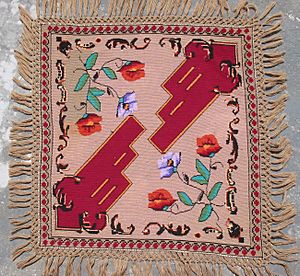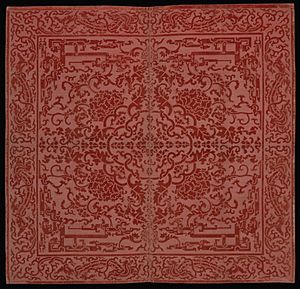Tablecloth facts for kids



A tablecloth is a piece of cloth used to cover a table. Some tablecloths are mostly for decoration. They can also help protect the table from scratches and spills. Other tablecloths are put on a dining table before you set out tableware and food.
Some tablecloths are part of a bigger table setting. They might match napkins, placemats, or other decorations. There are also special types of tablecloths. "Runners" are long cloths that hang over only two ends of the table. "Table protectors" are soft layers placed under a regular tablecloth.
Contents
Tablecloth Shapes and Sizes
Tablecloths come in many shapes. The most common ones are round, square, oval, and rectangular. These shapes match the most common table shapes.
Tablecloths usually hang over the edge of the table. This part is called the "drop." The drop is usually about 6 to 15 inches (15 to 38 cm) on each side. A shorter drop is good for everyday meals. A longer drop is used for more fancy events. Sometimes, a tablecloth can even reach the floor! You can also get tablecloths made just for your table. Some people even enjoy making their own.
Fabrics and How to Care for Them
Today, many dining tablecloths are made from cotton, a mix of polyester and cotton, or a PVC-coated material. The PVC-coated ones are easy to wipe clean. But tablecloths can be made from almost any material. This includes delicate fabrics like embroidered silk.
It's important for dining tablecloths to be easy to wash. This is because they can get dirty very quickly during meals.
A Look at Tablecloth History
The idea of using tablecloths is very old. The first known mention of a tablecloth was around 100 AD. It was written about by an ancient Latin poet named Martial.
For a long time in Europe, a white tablecloth was the standard for dinner tables. In the later Middle Ages, rich families would spread a high-quality white linen or cotton cloth on the table. This was a very important part of getting ready for a big feast. Over time, setting the table with a cloth became common for most people. Only the very poorest did not use them.
In the 20th century, eating habits changed. Many new ways to set a table appeared. Some formal dinners still use white tablecloths. These often have a special damask weave. But now, many other colors and patterns are also popular.
Special Tablecloth Styles
Since medieval times, special tablecloths and napkins have been made in Perugia, Italy. These cloths are white with unique woven blue stripes and patterns. This style is also used for church linen.
During the Victorian era, homes were filled with thick, colorful, fringed fabrics. This included tablecloths that reached all the way to the floor.
See also
 In Spanish: Mantel para niños
In Spanish: Mantel para niños

